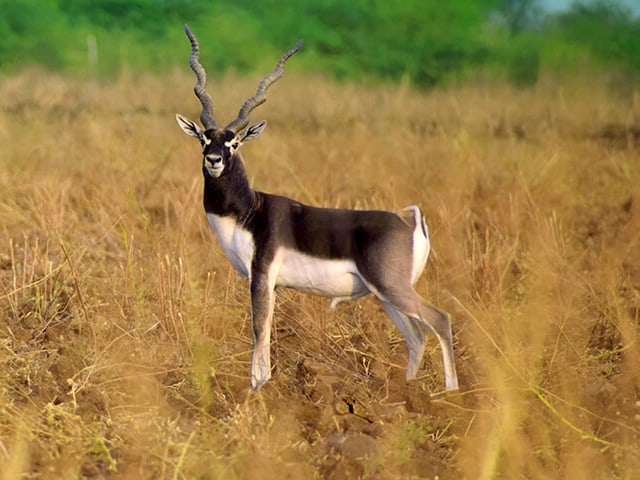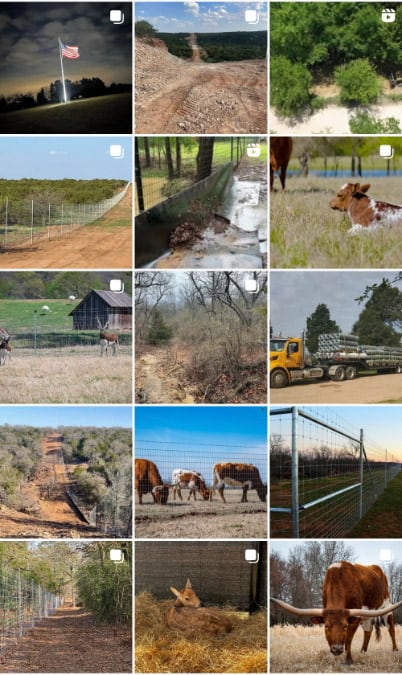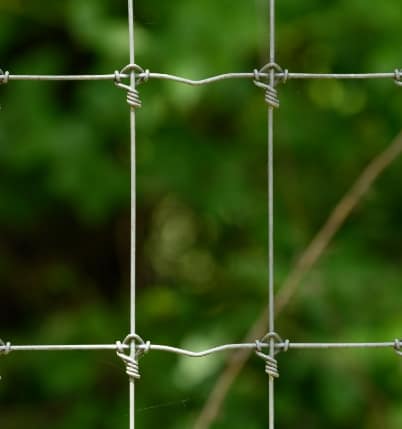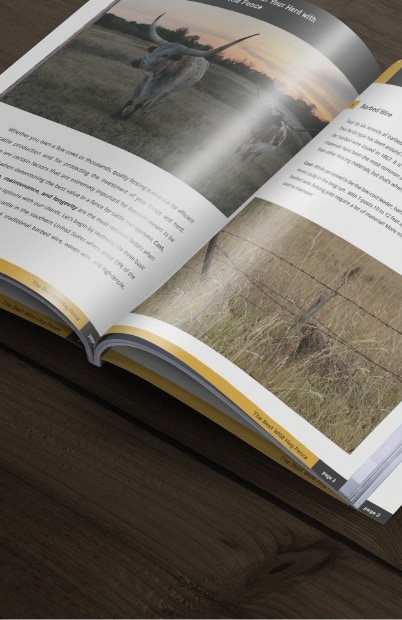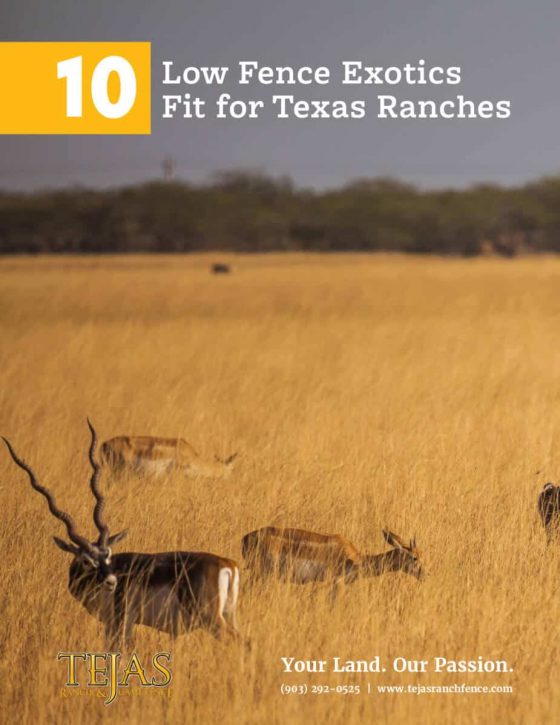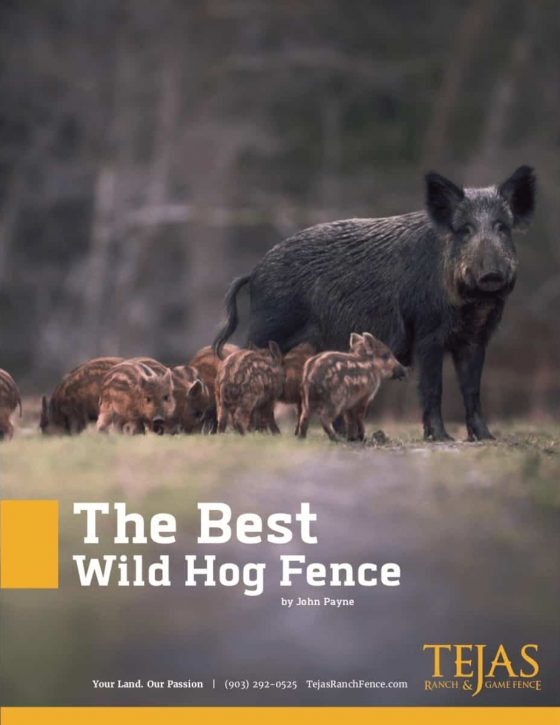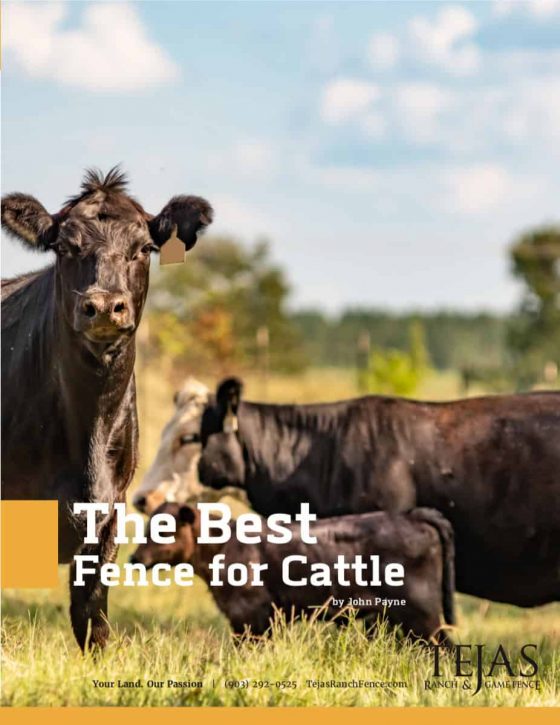The lure of low-fence exotics
Have you ever dreamed of sitting on your porch and watching exotic animals from around the world roam your ranch?
Blackbuck, bison, sheep, and a variety of other mammals that require little care are actually well suited for Texas ranches with the proper planning, selection, and fencing. These animals can be contained within 4 ½’ low fence of high tensile woven wire steel mesh using the “front pasture” concept developed by Tejas Ranch & Game Fence.
Tejas founder John Payne pioneered the front pasture design for a client whose animals were keeping their distance. Payne fenced 100 acres around the main house, added secure automatic gates, and contained the exotics with enough room to roam in sight of family and friends. Since then, the front pasture concept has become popular on ranches throughout East Texas. It’s fantastic to be able to watch the cycle of life unfold, as animals give birth and raise their young in a specially created habitat.
“With the right mix of animals in the right enclosure there’s great entertainment value for family and friends visiting the ranch,” says Payne. “It’s amazing how this concept can add interest and vitality to the ranch experience for folks of all ages. It’s like having an aquarium on the land where there’s always beauty and interesting activity happening, and with surprisingly little maintenance and care.”
First, the right low fence
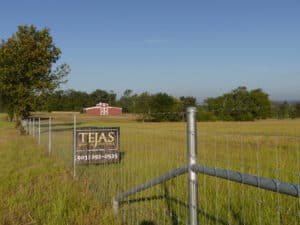 Many landowners assume that they need an 8’ high game fence to contain exotics on their property. For certain animals, however, a fence that stands 4 ½’ is sufficient. The key is to choose the correct fencing style and materials.
Many landowners assume that they need an 8’ high game fence to contain exotics on their property. For certain animals, however, a fence that stands 4 ½’ is sufficient. The key is to choose the correct fencing style and materials.
High tensile woven wire steel mesh with a “fixed knot” fencing is the material of choice for exotics, preferred over the common five-strand barb wire for its strength and safety and most importantly, for its resistance to predators. This modern form of the old field fence consists of a series of interconnected vertical and horizontal wires that form squares or rectangles of overlapping and knotted wires. It differs from field fence primarily in its strength, but also in the available patterns.
Woven wire comes in several varieties, but the main difference is the amount of spacing between the wires, both vertically and horizontally. Depending on the purpose, ranchers can select fencing with more or less space between the wires. Woven wire fencing is commonly used with cattle and horses to prevent fence injuries and entanglements and to keep feral hogs from destroying the precious grass in pastures. It is also sturdier and less susceptible to livestock damage, which makes it a longer lasting choice for a surprisingly small premium in price. Commercial hunting or breeding operations typically use this kind of high-grade, high- tensile, woven-wire steel mesh, known in the trade as fixed knot fencing.
Woven-wire, fixed knot basics: coating, knots, and spacing
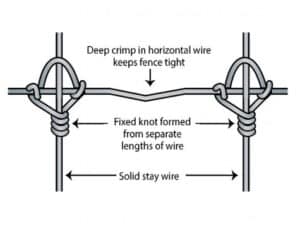
When selecting woven wire fences, there are three things to consider: galvanized coating, fixed knot design, and mesh spacing.
Class 3 galvanized high tensile wire and solid vertical stays require little to no maintenance, so landowners spend less time worrying about the integrity and durability of the fencing material.
A fixed-knot design combined with high tensile wire makes this the strongest woven wire fence available and highly resistant to animal damage. In fact, the breaking strength of each individual horizontal wire is around 1,400 lbs.
The steel mesh spacing enables the fence to withstand stresses without losing shape or strength. The crimps in the horizontal wires are installed with significant tension or pressure so they can withstand force from livestock.
Woven wire is also much more visible than standard, five-strand barbed wire, making it a safer solution in many cases.
Other considerations
Before acquiring exotics for your ranch, it’s important to consider how you’ll fence your property to ensure that your exotics have access to water, forage, protective vegetation, and supplemental feeding when grass is insufficient or dormant. A professional ranch fence contractor can analyze your property to help identify your particular needs.
Water gaps
Water gaps along fence lines can be tricky. Tejas Ranch & Game Fence has created a proprietary solution, the FloatMaster™ Water Gap, that solves this age-old problem. During high-water events, the FloatMaster™ will allow debris to flow freely below a fence, and during dry seasons it lies flat on the ground to prevent animals from escaping and predators from entering.
Gates
Typical gates constructed for cattle have gaps where the gates attached to the fence posts and between round tubing. Tejas installs gates so as to keep your exotics contained and safe from dogs and predators. Additionally, their exceptional gate latches are both reliable and secure.
As a standard offering, Tejas uses galvanized posts, T-posts, and wire for a uniform appearance and a longer lasting fence. These materials, which enhance your investment, come at a very small premium over ungalvanized fencing.
Feeding and drinking stations
Often overlooked, feeding stations and drinking systems can be critical. Appropriate nutrition is important for any wildlife. Ensuring that your land can support additional grazers takes proper management. Automatic and gravity-fed feeders can be important additions for exotics. Tejas sells a full range of top-quality reliable spin cast and protein feeders. Adding feeding stations along with new wildlife can help ensure the success of your vision.
Texas summers can be brutal on livestock and wildlife. Providing reliable sources of water can reduce stress and ensure better health for your animals. Surface water stock tanks are the easiest hydration solution, but if you have water running to certain pastures, automatic waterers are a simple investment.
Compatibility
Selecting the right low-fence exotics also requires research and careful consideration of habitat, climate, and species compatibility. Some species will hybridize, interbreed, or populate quickly if not kept in check. If you are introducing exotics with your native whitetails, consider that whitetail deer will likely land at the bottom of the pecking order for food if your property is at carrying capacity. Predator control is also a must as coyotes and feral hogs will kill fawns. (Learn about Tejas’ predator-proof fencing)
Local agricultural extension agents, wildlife biologists (with exotics expertise), and the Exotic Wildlife Association (EWA) can be excellent resources and can help guide your choices alongside the team at Tejas Ranch & Game Fence. The EWA has published a helpful list of seven tips for landowners considering adding exotics to their property.
Low-fence exotics to consider
Along with its expertise in designing and constructing fences for exotic enclosures, the Tejas team has curated a list of *low-fence exotics suited for woven-wire fenced pastures.
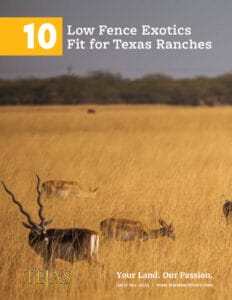 |
Interested in downloading and taking this article with you? Click to download the printable PDF version. |
-
-
Addax
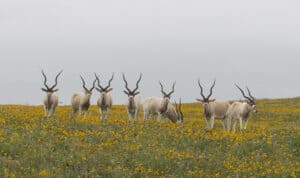 Also known as the white antelope and the screwhorn antelope, the addax is native to North Africa’s Sahara desert where it is a critically endangered species. A medium sized antelope (41 to 45 inches at the shoulder), the addax is known for long spiral horns on males and females that grow up to 30 inches. Its coat also changes color with the seasons. In winter, the beast is greyish-brown with white hindquarters and legs and long, brown hair on its head and neck while in summer, its coat turns almost completely white or sandy blonde.
Also known as the white antelope and the screwhorn antelope, the addax is native to North Africa’s Sahara desert where it is a critically endangered species. A medium sized antelope (41 to 45 inches at the shoulder), the addax is known for long spiral horns on males and females that grow up to 30 inches. Its coat also changes color with the seasons. In winter, the beast is greyish-brown with white hindquarters and legs and long, brown hair on its head and neck while in summer, its coat turns almost completely white or sandy blonde.Addax live up to 25 years in captivity and 19 years in the wild. This desert-adapted antelope feeds on grasses, shrubs, leaves, wood, bark, and stems. Surprisingly, they get most of the water they need through the vegetation they eat. Overall, the addax makes a great addition to the pasture.
-
Blackbuck
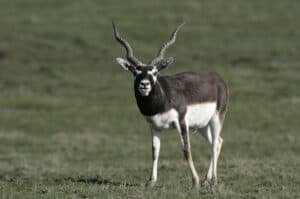 Widely regarded as one of the most striking animals, the blackbuck has a two-tone coat with a deep brown to black back and white underbelly. Also known as the Indian antelope, it is native to India, Nepal, and Pakistan. It stands 29 to 33 inches high at the shoulder; males weigh about 84 pounds. The long, ringed horns are generally present only on males. Blackbuck are grazers and eat mainly grasses, leaves, buds, and field fruits. They typically live 15 years in the wild.
Widely regarded as one of the most striking animals, the blackbuck has a two-tone coat with a deep brown to black back and white underbelly. Also known as the Indian antelope, it is native to India, Nepal, and Pakistan. It stands 29 to 33 inches high at the shoulder; males weigh about 84 pounds. The long, ringed horns are generally present only on males. Blackbuck are grazers and eat mainly grasses, leaves, buds, and field fruits. They typically live 15 years in the wild. -
Buffalo
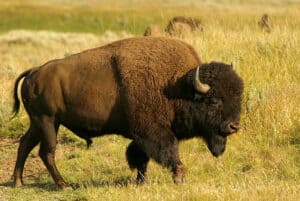 When people speak of the American bison and the American buffalo, they are referring to the same animal. The American buffalo once numbered over 65 million strong across almost the entire continent of North America. By the end of the 1800s their numbers had been reduced to a few hundred. Now with organized conservation efforts, the number of wild bison roaming the open range has grown to about 16,000 while there are close to 500,000 animals living in large, privately owned herds.
When people speak of the American bison and the American buffalo, they are referring to the same animal. The American buffalo once numbered over 65 million strong across almost the entire continent of North America. By the end of the 1800s their numbers had been reduced to a few hundred. Now with organized conservation efforts, the number of wild bison roaming the open range has grown to about 16,000 while there are close to 500,000 animals living in large, privately owned herds.The buffalo is the largest land animal in North America and lives 16 to 25 years. Bulls are impressive and average 6 feet tall at the shoulders with an average weight of 2,000 pounds. Both males and females have horns. Their fur is brown with hair that is longer in the front than in the back. They primarily eat grass and reproduce once a year, giving birth to a single calf.
-
Père David’s Deer
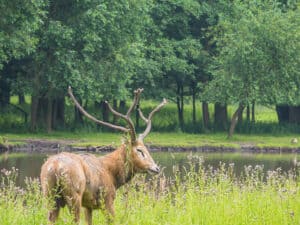 Native to northern China, the rare Père David’s deer is found now only in zoos, private animal collections, and game reserves. The deer stands about 43 inches tall at the shoulder and is characterized by heavy legs, broad hooves, relatively small ears, and a long, bushy tail. Its coat is reddish brown in summer and grayish brown in winter. The male has impressive long antlers that fork shortly above the base with the front prong branching once and the rear prong extending backward unbranched. The deer breed well in captivity and now survive in zoos and game parks around the world. They enjoy water and will spend 30 percent or more of their time in and around water features. Average lifespan is about 18 years. They primarily eat grass and during the summer will eat many aquatic plants.
Native to northern China, the rare Père David’s deer is found now only in zoos, private animal collections, and game reserves. The deer stands about 43 inches tall at the shoulder and is characterized by heavy legs, broad hooves, relatively small ears, and a long, bushy tail. Its coat is reddish brown in summer and grayish brown in winter. The male has impressive long antlers that fork shortly above the base with the front prong branching once and the rear prong extending backward unbranched. The deer breed well in captivity and now survive in zoos and game parks around the world. They enjoy water and will spend 30 percent or more of their time in and around water features. Average lifespan is about 18 years. They primarily eat grass and during the summer will eat many aquatic plants. -
Rhea
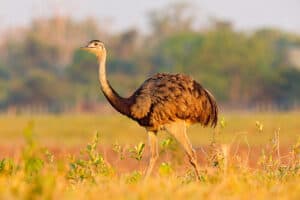 These flightless birds, native to South America, are remotely related to ostrich and emu. In South America they thrive in open country from Brazil to Argentina and from Peru to Patagonia. Considerably smaller than the ostrich; the rhea stands about 4 feet tall and weighs about 50 pounds. The common rhea has brown or gray upper parts and whitish underparts. Darwin’s rhea is somewhat smaller and its brownish plumage is tipped with white. Pure white rhea are available from domestic sources and add variety and interest to ranch livestock collections. The average lifespan of these birds is about 13 years in captivity.
These flightless birds, native to South America, are remotely related to ostrich and emu. In South America they thrive in open country from Brazil to Argentina and from Peru to Patagonia. Considerably smaller than the ostrich; the rhea stands about 4 feet tall and weighs about 50 pounds. The common rhea has brown or gray upper parts and whitish underparts. Darwin’s rhea is somewhat smaller and its brownish plumage is tipped with white. Pure white rhea are available from domestic sources and add variety and interest to ranch livestock collections. The average lifespan of these birds is about 13 years in captivity.These birds enjoy room to run and can outpace predators. They thrive in open, treeless areas, as long as there is some cover available. Rheas are omnivorous and eat a wide variety of plants and animals such as grass, leguminous crops, and grain. Rhea also eat small birds, fish, snakes, and insects. Fun facts: male rheas incubate the eggs and raise the young, though the male and female birds do not form lasting pairs. It is great fun to see the baby rhea following in small pack behind their fathers as they teach them to forage for food.
-
Scimitar Oryx
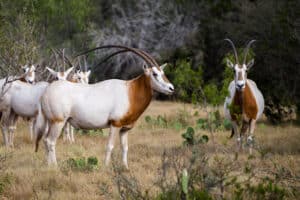 Both the male and female scimitar oryx sport the famed long, ribbed, backward curving horns. Mostly white with reddish brown necks and markings, the scimitar oryx has a long, dark, tufted tail. These desert antelope stand up to 4.6 feet tall at the shoulder with a head and body length between 4.9 and 7.5 feet. They weigh between 220 pounds (females) and 460 pounds (males). Scimitar oryx live about 27 years in captivity. They are herbivorous, feeding on annual grasses, herbs, juicy roots, buds, and, when water is scarce, on fruits and vegetables.
Both the male and female scimitar oryx sport the famed long, ribbed, backward curving horns. Mostly white with reddish brown necks and markings, the scimitar oryx has a long, dark, tufted tail. These desert antelope stand up to 4.6 feet tall at the shoulder with a head and body length between 4.9 and 7.5 feet. They weigh between 220 pounds (females) and 460 pounds (males). Scimitar oryx live about 27 years in captivity. They are herbivorous, feeding on annual grasses, herbs, juicy roots, buds, and, when water is scarce, on fruits and vegetables.Hundreds of thousands of oryx roamed the Sahara and Sahel regions of Northern Africa only a century ago. Because of human disturbance, over-hunting, drought, and excessive livestock grazing, the scimitar oryx is now believed to be extinct in the wild. Surveys show that Niger and Chad may have appropriate habitat for reintroduction, and some reintroductions have begun in Tunisia.
-
Sheep
-
Barbados Blackbelly
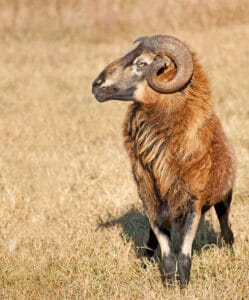 A domestic sheep from the Caribbean island of Barbados, the Barbados Blackbelly males weigh between 100 and 130 pounds. They come in all shades of brown, tan, or yellow, generally with black or brown faces. As the name suggests, their bellies are black. They are extremely hardy and strong. While they thrive in the hot and humid climates, they also do well in colder climates. They display an alert and docile temperament and reproduce non-seasonally, generally giving birth to two or three offspring. They are excellent foragers and highly resistant to disease. Today, the breed is raised mainly for its meat, which has an excellent mild flavor.
A domestic sheep from the Caribbean island of Barbados, the Barbados Blackbelly males weigh between 100 and 130 pounds. They come in all shades of brown, tan, or yellow, generally with black or brown faces. As the name suggests, their bellies are black. They are extremely hardy and strong. While they thrive in the hot and humid climates, they also do well in colder climates. They display an alert and docile temperament and reproduce non-seasonally, generally giving birth to two or three offspring. They are excellent foragers and highly resistant to disease. Today, the breed is raised mainly for its meat, which has an excellent mild flavor. -
Black Hawaiian
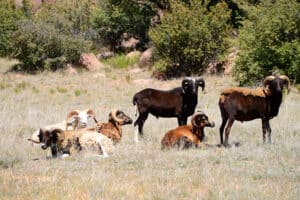 Although its origins are murky — some say the Black Hawaiian sheep is a Barbados ram with a genetic mutation while others claim it’s a black hair-mouflon cross — the sheep is distinctive with a thick black coat and horns that can grow more than 40 inches long. Males usually weigh up to 150 pounds while females are about half as heavy. Black Hawaiian sheep are resilient, disease resistant, and can survive in extreme climates. They are popular with sportsmen because of their agility, size, and horns.
Although its origins are murky — some say the Black Hawaiian sheep is a Barbados ram with a genetic mutation while others claim it’s a black hair-mouflon cross — the sheep is distinctive with a thick black coat and horns that can grow more than 40 inches long. Males usually weigh up to 150 pounds while females are about half as heavy. Black Hawaiian sheep are resilient, disease resistant, and can survive in extreme climates. They are popular with sportsmen because of their agility, size, and horns. -
Corsican
A cross between the Barbados Blackbelly and mouflon, Corsican sheep were introduced to Texas almost 50 years ago. A challenging animal, they have become the most hunted exotic animal throughout the country. They herd quickly and are difficult to track down. Corsican males weigh between 130 and 160 pounds; females are between 80 to 100 pounds. The males’ horns can weigh up to 30 pounds and can actually outweigh the rest of the bones in their bodies combined. The average horn starts at 14 inches, and as the animal matures, the horn length grows 25 to 38 inches. Ewes have smaller horns. The Corsican ram has a beautiful and unique hide with bold black accents on its brown neck, sides, and legs. The mane on the lower neck is usually between 3 to 8 inches and grows longer and thicker in the winter. Corsican rams are grazers and consume large amounts of browse.
-
Four Horned Sheep
Native to ancient Syria, the Four Horned Sheep are white with colored spots or patches. Females weigh 80 to 120 pounds and males 120 to 180 pounds. Both sexes are horned; rams grow an impressive set up to 40 inches long. They are docile and are bred for their wool. These very unique multi-horned sheep are a great novelty to add to your low-fence pasture.
-
Painted Desert Sheep
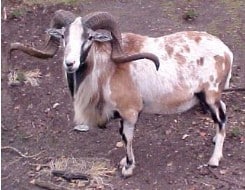 The Painted Desert Sheep is known primarily for the ram’s ability to grow a trophy-class set of horns. Females may range in weight from 60 to 120 pounds and have heights from 21 to 25 inches at the shoulders. Rams weigh from 75 to 200 pounds and may be 30 inches or more at the shoulders. The Painted Desert Sheep adapt well and are resistant to disease, heat, and cold. They are great lot cleaners, known for clearing fence lines and wooded or overgrown lots. The rams will grow a luxuriant mane–another feature that makes them a favorite of trophy hunters.
The Painted Desert Sheep is known primarily for the ram’s ability to grow a trophy-class set of horns. Females may range in weight from 60 to 120 pounds and have heights from 21 to 25 inches at the shoulders. Rams weigh from 75 to 200 pounds and may be 30 inches or more at the shoulders. The Painted Desert Sheep adapt well and are resistant to disease, heat, and cold. They are great lot cleaners, known for clearing fence lines and wooded or overgrown lots. The rams will grow a luxuriant mane–another feature that makes them a favorite of trophy hunters. -
Mouflon
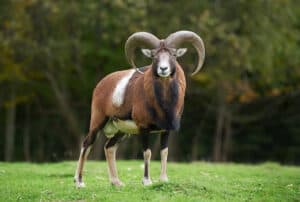 Native to the Mediterranean islands, the mouflon sheep is muscular with a noble build. It is very athletic and sleek in its stance, about 28 inches at the shoulder, and brown with white underparts. The male has a light, saddle-shaped mark on its back and has large, downward curving horns with the tips turned outward. The female is usually hornless (a sign of past domestication). Like the domestic sheep, mouflons mainly eat grass, but they also occasionally browse from shrubs or trees.
Native to the Mediterranean islands, the mouflon sheep is muscular with a noble build. It is very athletic and sleek in its stance, about 28 inches at the shoulder, and brown with white underparts. The male has a light, saddle-shaped mark on its back and has large, downward curving horns with the tips turned outward. The female is usually hornless (a sign of past domestication). Like the domestic sheep, mouflons mainly eat grass, but they also occasionally browse from shrubs or trees. -
Texas Dall
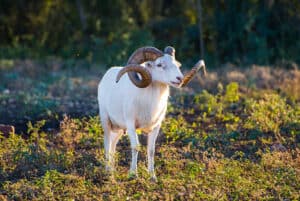 Native to North America, the Texas Dall sheep is a hybrid cross of mouflon ewes and Rambouillet rams. It ranges in color from white to slate brown and has curved yellowish brown horns. Texas Dall males typically weigh between 130 and 160 pounds. These animals were bred by sportsmen.
Native to North America, the Texas Dall sheep is a hybrid cross of mouflon ewes and Rambouillet rams. It ranges in color from white to slate brown and has curved yellowish brown horns. Texas Dall males typically weigh between 130 and 160 pounds. These animals were bred by sportsmen.
-
-
Zebra
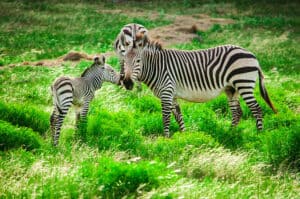 Known and beloved by children everywhere for its distinctive brown or black and white stripes, the zebra is native to Africa where great herds still run on the Serengeti plain and live south of the Sahara and on the southwest coastal plains. Their standing height ranges from 4 to 5 feet at the shoulders; they weigh approximately 600 pounds. Most experts divide zebras into three species – plains zebra, Grevy’s zebra, and mountain zebra with the Hartmann’s zebra a subspecies of the mountain zebra. Others consider the Hartmann’s zebra a species unto itself. Additionally, there are numerous subspecies. Their color and pattern make them desirable ranch animals. They are hearty, disease resistant, and rarely require special care. The zebra’s average lifespan in the wild is 25 years, but the animal can live to be 30 years old in captivity. They are herbivores and primarily eat a variety of grasses. They are also known to eat shrubs, herbs, twigs, leaves, and bark.
Known and beloved by children everywhere for its distinctive brown or black and white stripes, the zebra is native to Africa where great herds still run on the Serengeti plain and live south of the Sahara and on the southwest coastal plains. Their standing height ranges from 4 to 5 feet at the shoulders; they weigh approximately 600 pounds. Most experts divide zebras into three species – plains zebra, Grevy’s zebra, and mountain zebra with the Hartmann’s zebra a subspecies of the mountain zebra. Others consider the Hartmann’s zebra a species unto itself. Additionally, there are numerous subspecies. Their color and pattern make them desirable ranch animals. They are hearty, disease resistant, and rarely require special care. The zebra’s average lifespan in the wild is 25 years, but the animal can live to be 30 years old in captivity. They are herbivores and primarily eat a variety of grasses. They are also known to eat shrubs, herbs, twigs, leaves, and bark.
-
Wrapping up
We’ve covered a lot of ground. The takeaway: start with the proper low fence. High tensile wire mesh fencing with fixed knots is the best choice to safely contain exotic animals. Adding low fence exotics to your property is very doable with this fence material, water gap solutions, proper gates, and feeding stations.
With the right planning and support, you can look forward to watching from your porch as spectacular exotic animals meander across your land.
For additional information on low-fence exotics, call the professionals at Tejas Ranch & Game Fence.
 |
Interested in downloading and taking this article with you? Click to download the printable PDF version. |
Would you like more articles about low-fence exotics sent directly to your inbox? Sign up for our newsletter.
*When pressured, most of these animals have the capability to jump any fence. However, given enough room, these animals will not jump a low fence.
